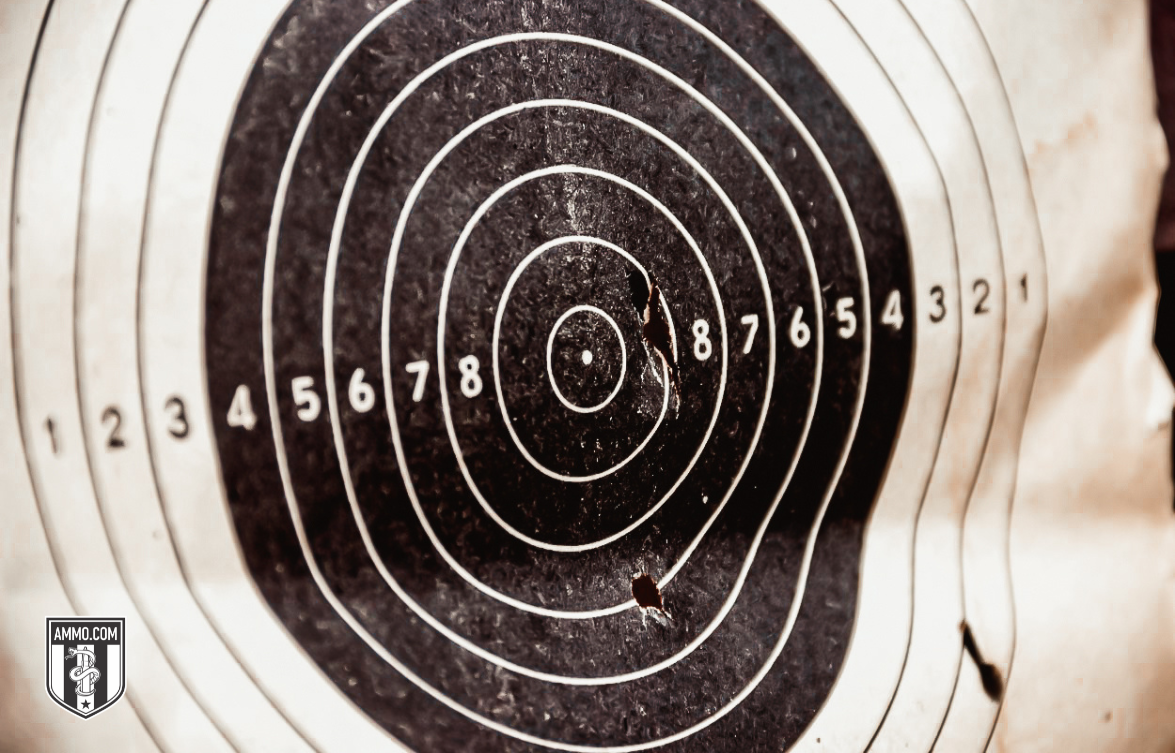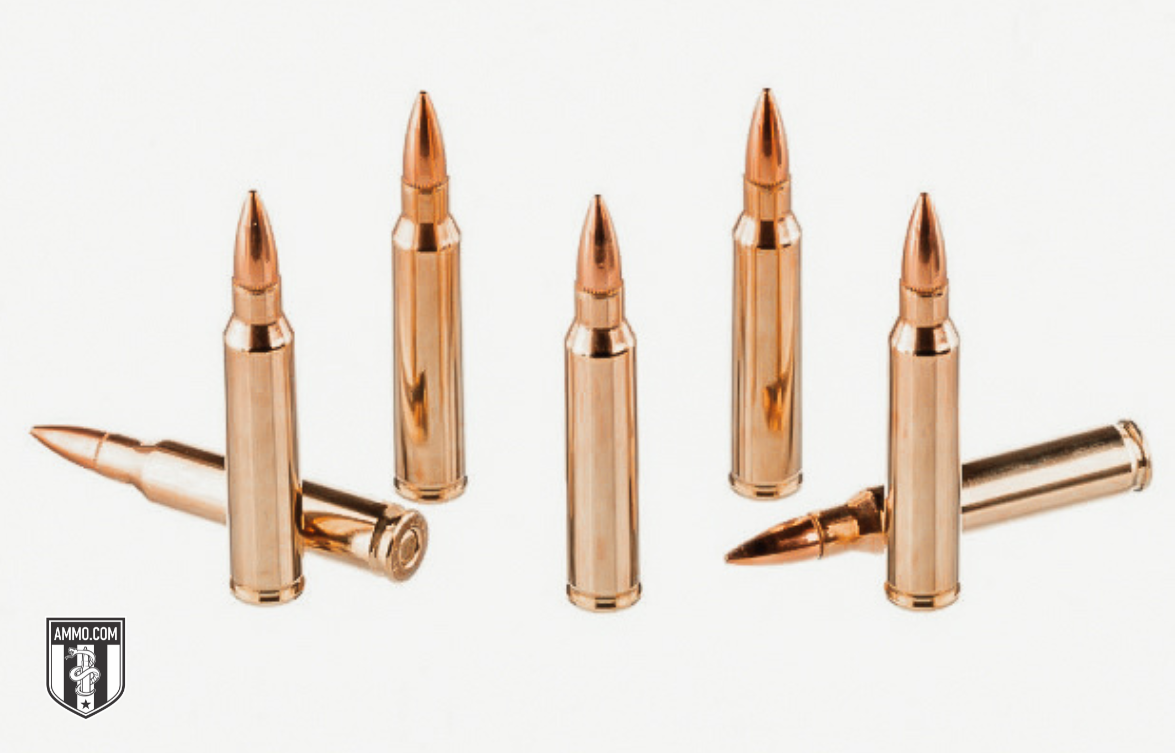22 ARC vs. 223 Remington: Comparing .224 Caliber Cartridges
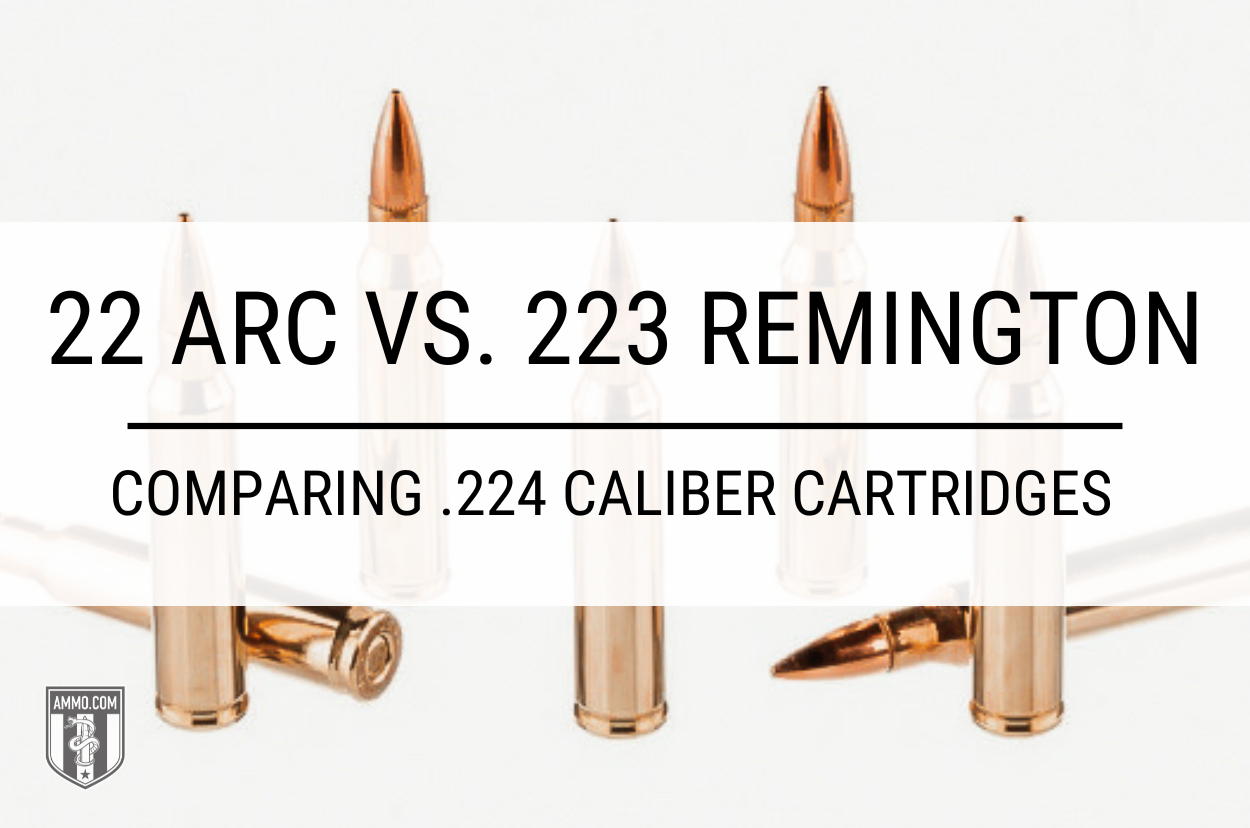
The 22 Advanced Rifle Cartridge (22 ARC) and 223 Remington (223 Rem) are very similar rounds with a few distinct differences that make one the better choice for most applications.
We’ll compare the 22 ARC vs. 223 Rem in terms of real-world performance, including their recoil, trajectory, and suitability for hunting and defense, so you can decide which .22 caliber rifle cartridge better suits your needs.
Let’s start discussing the differences between the 223 Rem and 22 ARC!
What’s the Difference Between 22 ARC and 223?
The most significant difference you’ll notice between these two rounds is between their base diameters. The observant will also see the difference in their projectiles. Yes, both fire 0.224” diameter bullets, but that’s where the bullets’ similarities end.
We’ll begin with the differences in cartridge specs and continue with how they affect performance.
Cartridge Specifications
The 22 ARC is often thought to be based on the 6mm ARC, though its parent case is actually the 6.5 Grendel. It utilizes a 0.224” diameter bullet, and has a case with a neck diameter of 0.221”, base diameter of 0.441”, and length of 1.525”. The overall length is 2.260”, with a case capacity of 34.6 grains H2O and maximum pressure of 52,000 psi.
The .223 Remington descended from the .222 Remington parent case. It also fires a 0.224” diameter bullet. The case has a 0.253” neck diameter, 0.375” base diameter, 1.760” length, and capacity of 28.8 grains H2O (slightly less than the 22 ARC). At 55,000 psi, the 223 Rem has a higher max pressure than the 22 ARC.
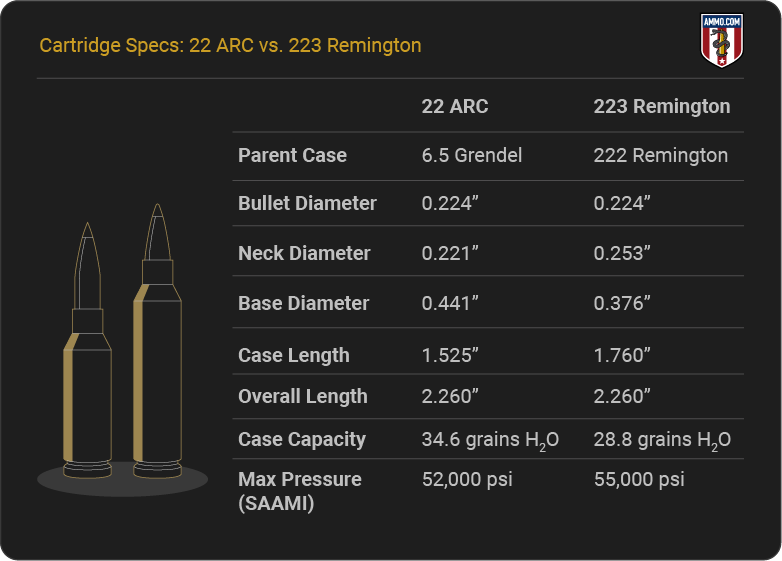
Recoil: 22 ARC vs. 223 Rem
I always compare recoil because it’s one of the first things a new shooter asks: “How hard does it kick?” A cartridge with more recoil kicks the muzzle farther off the target with each shot, thus slowing follow-up shots. Strong recoil can also cause the shooter to flinch, which further worsens marksmanship. The less recoil you feel, the more accurately you can fire.
Both rounds have virtually non-existent recoil, but we’ll dive in to give you a better idea for each. I base my comparison on free recoil energy because unlike “felt recoil” it is objective. It’s a measure of recoil determined by four variables: projectile weight, propellant weight, muzzle velocity, and firearm weight.
When a 62 grain 223 Rem bullet is fired from an 8-pound rifle at 3,025 fps muzzle velocity, it generates about 4 ft-lbs of recoil energy.
When a 62 grain 22 ARC bullet is fired from an 8-pound rifle at 3,300 fps muzzle velocity, it generates about 2.5 ft-lbs of recoil energy.
While the 22 ARC technically has less recoil, the difference is so minuscule that most shooters won’t notice much difference. This section is a tie.
Trajectory
A bullet’s trajectory is its path to the target. Although we often talk about "flat-shooting guns," a bullet's trajectory is rarely flat. Instead, it frequently resembles an arch: rising, plateauing, and ultimately dropping.
When fired at targets within 100 yards, most rifle cartridges exhibit virtually zero bullet drop. As distance increases, bullet drop becomes more pronounced. This is partly because a bullet’s velocity steadily slows throughout its trajectory. A bullet requires more time to cover 100-200 yards than 0-100. As a result, gravity has more time to exert its influence on a bullet as it covers farther distances.
When a 22 ARC 62 grain ELD-VT bullet is sighted in at 200 yards, it will drop -5.6” at 300 yards, -16.4” at 400 yards, and -33.5” at 500 yards. The 22 ARC is a flat-shooting cartridge.
When a 223 Rem 62 grain FMJ bullet is sighted in at 200 yards, it will drop -7.5” at 300 yards, -22.7” at 400 yards, and -48.2” at 500 yards.
While the 223 Rem has a reasonably flat trajectory, the 22 ARC was designed to have a flatter trajectory. It wins this section.
Accuracy: 223 Rem vs. 22 ARC
Accuracy is more often a function of the shooting platform and the shooter than of the cartridge itself. The ammo, rifle, environmental conditions, and shooter all affect a cartridge’s accuracy.
For the sake of argument, we’ll only consider the cartridges' trajectories and recoil energy. Most shooters will find they are more accurate with the 22 ARC because it has slightly less recoil and a flatter trajectory: two characteristics that rarely go together.
The 22 ARC wins this section, but both cartridges are incredibly accurate in the hands of a capable shooter.
Ballistic Coefficient
A bullet’s ballistic coefficient (BC) reflects how effectively it resists wind deflection and frontal air resistance. Put another way, it’s a numeric representation of how aerodynamic a bullet is. A higher BC is preferable for long-distance shooting, as it indicates the bullet will exhibit a more predictable trajectory.
Sleeker, heavier bullets have higher BCs than bulkier, lighter projectiles. The 22 ARC capitalizes on high-BC bullets. Its G1 BC ranges from 0.395 to 0.485, while the 223 Remington's ranges from 0.100 to 0.252.
The 22 ARC's higher-BC projectiles win this section.
Stopping Power: 22 ARC vs. 223 Rem

“Stopping power” is a delicate subject amongst shooters. Some believe in getting by with as little power as possible, claiming a well-placed shot is effective regardless of bullet size. Others adhere to the go-big-or-go-home mentality, claiming a more powerful round compensates for less-than-ideal shot placement.
Let’s make things simple and agree that stopping power is determined by penetration depth, wound column diameter, and kinetic energy transfer.
Since both cartridges fire 0.224” diameter bullets in similar weights, they will inflict similarly wide and deep wound columns. However, the 22 ARC achieves higher velocities and conserves more kinetic energy downrange as a result.
A 62 grain ELD-VT 22 ARC bullet will have 1,081 ft-lbs of energy at 200 yards and 636 ft-lbs at 500.
A 68 grain BTHP 223 Rem bullet will have 906 ft-lbs of energy at 200 yards and 482 ft-lbs at 500.
While neither round has tremendous stopping power, the 22 ARC has more than the 223 Rem when firing similarly heavy bullets. It wins this section.
Hunting
Both cartridges can ethically harvest medium game like whitetail deer. However, some states prohibit the use of .22 caliber bullets for deer hunting.
These cartridges excel at varmint hunting. While the .22-250 Remington had been the gold standard for coyote hunting for many years, the 22 ARC now offers varmint hunters better ballistics. It’s certainly better for varmint hunting than the 223 Rem.
The 22 ARC offers hunters a little more stopping power and a flatter trajectory, so it wins this section.
Defense: 223 Remington vs. 22 Advanced Rifle Cartridge
I rarely recommend rifle cartridges for home defense because most of them are more likely to over-penetrate and endanger innocent bystanders than typical handgun cartridges. However, if I were forced to choose between these two cartridges for self-defense, I would use the 223 Remington because it has a few more bullet options (including subsonic rounds).
The 223 Remington wins this section.
Cost/Availability
Since the 22 ARC is still a new cartridge (especially compared to the 223 Rem), 22 ARC ammo is less abundant and more expensive. Hornady is currently the only major manufacturer producing it, so you won’t have as many bullet or price options for the foreseeable future. It’s still not expensive by rifle cartridge standards, but it’s costlier than 223 Rem ammo.
In contrast, nearly every ammo manufacturer makes 223 Rem. It’s abundant and relatively inexpensive for rifle ammo.
The 223 Rem wins this section.
Reloadability
Reloading is an excellent way to craft the perfect round for your firearm and save a little money. The initial investment in supplies and equipment deters most from starting to handload. But once upfront costs are behind you, you can create higher-quality ammo for low prices and enjoy total control over most of the process.
Both cartridges are reloadable with plenty of supplies, so this section is a tie.
22 ARC vs. 223 Ballistic Charts
The team at Ammo.com has created ballistic charts for the 22 ARC and 223 Rem, so you can quickly compare them.
22 ARC Ballistics
Administrative Note: The information below comes from the manufacturers. The actual ballistics obtained with your firearm can vary considerably from the advertised ballistics. Also, ballistics can vary from lot to lot with the same brand and type load. When manufacturer ballistic data were unavailable, ballistics were calculated using a ballistics calculator.
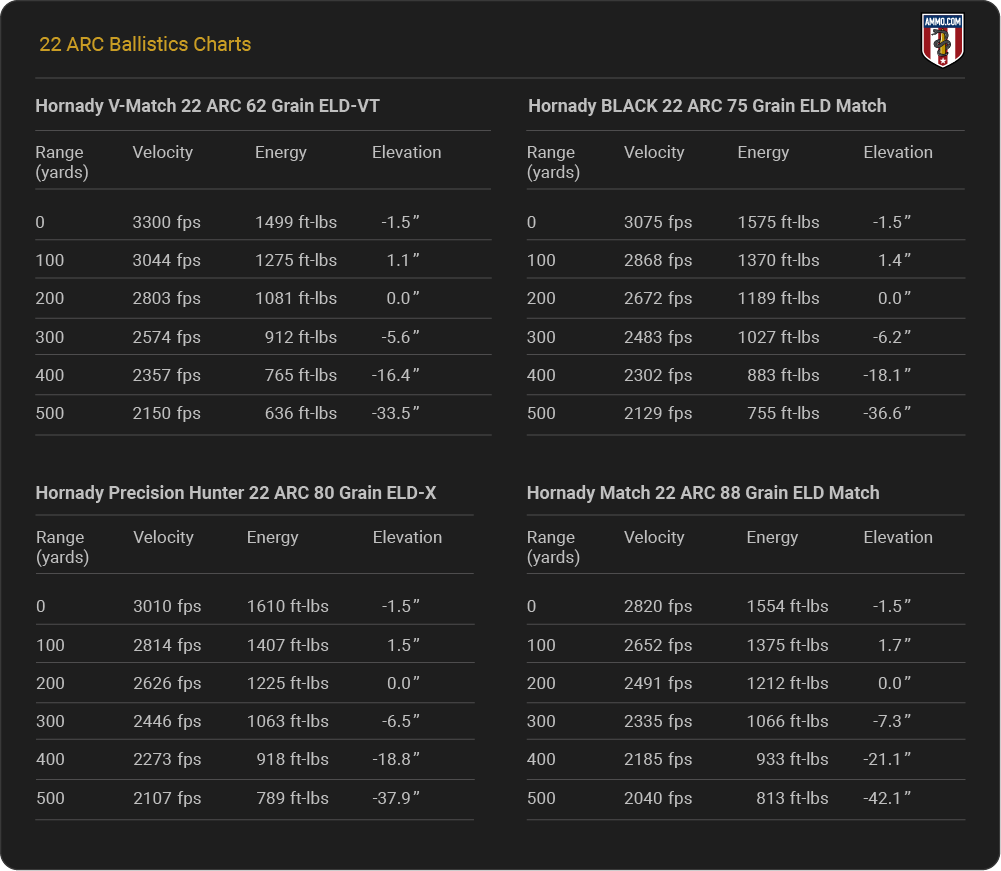
Take a deep dive into 22 ARC ballistics for factory ammo.
223 Remington Ballistics
Administrative Note: The information below comes from the manufacturers. The actual ballistics obtained with your firearm can vary considerably from the advertised ballistics. Also, ballistics can vary from lot to lot with the same brand and type load. When manufacturer ballistic data were unavailable, ballistics were calculated using a ballistics calculator.
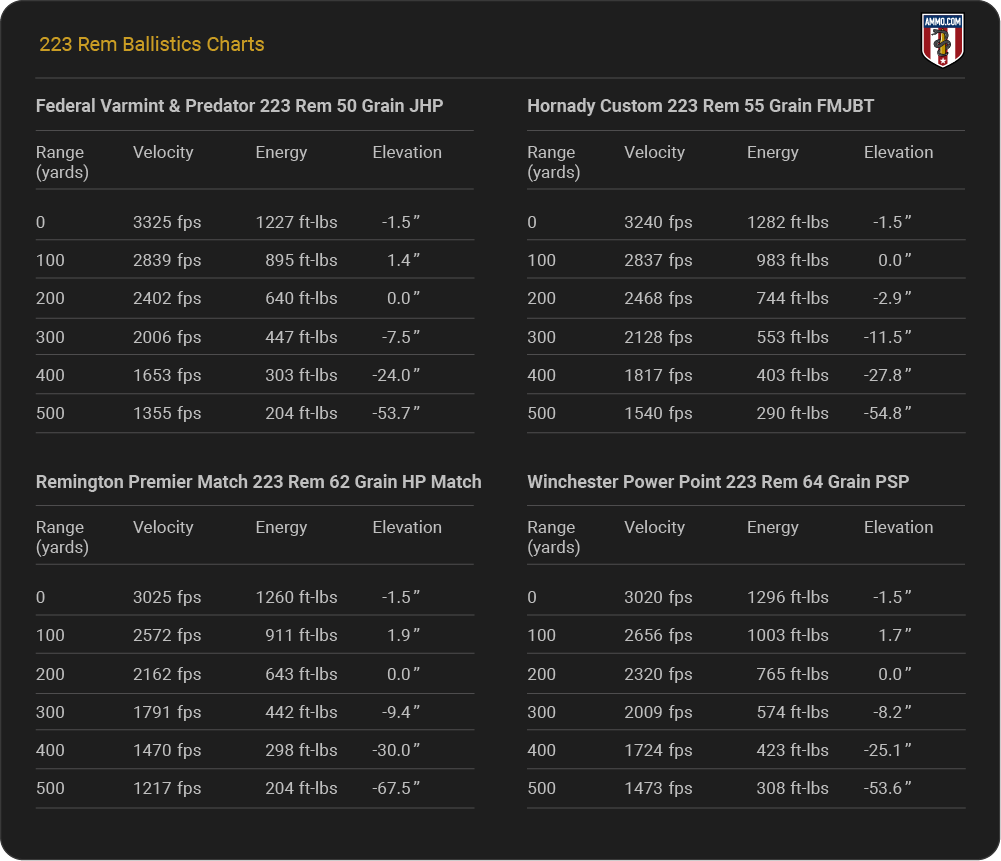
Take a deep dive into 223 Remington ballistics for factory loads.
22 ARC Brief History
In 2024, Hornady released the 22 Advanced Rifle Cartridge. It was designed to be accurate, fast, and flat-shooting, and have outstanding long-range capabilities for a .22 caliber round.
The verdict is still out as to whether the market will fully embrace this cartridge. Based on its ballistics alone, one might expect varmint hunters to trade in their .22-250 Remington rifles for 22 ARC. Of course, that would overlook how devoted most hunters are to their favorite rounds.
223 Rem Brief History
In 1964, the U.S. Army officially adopted the 223 Rem as "Cartridge, 5.56 mm ball, M193." This round was eventually replaced by the highly similar (albeit not identical) 5.56x45mm NATO. It was first used in the Army’s new M16 rifle during the Vietnam War, in which it proved effective.
The 223 Rem was released to the civilian market one year before the U.S. Army adopted it. Varmint hunters enjoyed the cartridge’s low recoil and high accuracy. Today, 223 Rem and 5.56x45mm are two of the most popular cartridges in the U.S. for target shooting and varmint hunting.
Parting Shots: 22 ARC vs. 223 Rem
Now that you’ve finished reading this 22 ARC vs. 223 Remington comparison, you know that the 22 ARC won five sections (trajectory, accuracy, ballistic coefficient, stopping power, and hunting capabilities). Two sections were tied (recoil and reloadability), and the 223 Remington won two sections (defense and overall cost/availability).
The 22 ARC easily wins this comparison. However, shooters are often slow to adopt new cartridges because they are relatively hard to find, fewer rifles are chambered for them, and rounds often become obsolete shortly after they’re introduced. It still has an uphill battle when trying to compete with the 223 Remington because the 223 Rem has been proven effective for many decades.
Don’t forget to grab all the ammo you’ll ever need at Ammo.com, no matter which cartridge you choose!
Frequently Asked Questions
The team at Ammo.com has gathered and answered some of the most commonly asked questions regarding 22 ARC vs. 223 Rem.
How Does the 22 ARC Perform Compared to the .223 Remington in Terms of Range and Accuracy?
The 22 ARC performs incredibly well compared to the .223 Remington in terms of range and accuracy. It has a flatter trajectory and more kinetic energy, which allows it to have a farther effective range. The recoil is less, which allows shooters to remain incredibly accurate even at long distances.
What Are the Differences in Performance Between the .22 ARC and the .223 Remington for Varmint Hunting?
The differences in performance between the .22 ARC and the .223 Remington for varmint hunting are the .22 ARC can take farther ethical shots because it has a flatter trajectory and more kinetic energy.
What Are the Ballistic Differences Between .22 ARC and .223 Remington?
The ballistic differences between the .22 ARC and .223 Remington are the 22 ARC has a flatter trajectory and achieves higher velocities and more kinetic energy.
Ammo Comparisons
- .308 vs 5.56
- 6.5 Creedmoor vs .308
- .300 Blackout vs .308
- .300 Win Mag vs .308
- .243 vs .308
- .308 vs .30-06
- 7mm-08 vs .308
- .270 vs .308
- 7.62x39 vs .308
- .223 vs .308
- .338 Lapua vs .308
- .380 ACP vs 9mm
- .223 vs 5.56
- .300 Blackout vs 5.56
- 9mm vs 45 ACP
- 9mm vs 40 S&W
- .357 SIG vs 9mm
- 10mm vs 9mm
- 9mm vs 9mm Luger
- .243 vs .270
- .300 Win Mag vs .30-06
- .270 vs .30-06
- .40 vs .45
- 38 Special vs 357
- 9mm vs 40 vs 45
- 5.56 vs 7.62x39
- 338 Lapua vs .30-06
- .30-30 vs .30-06
- 300 PRC vs 338 Lapua
- .30-06 vs 7mm
- 300 Win Mag vs 338 Lapua
- 300 PRC vs 300 Win Mag
- 300 WSM vs 300 Win Mag
- 338 Win Mag vs 338 Lapua
- 12 Gauge vs 20 Gauge
- 10mm vs 357 Mag
- .30-30 vs 7.62x39
- 224 Valkyrie vs 22-250
- 17 HMR vs 22 Mag
- 7.62x39 vs .300 Blackout
- 45 ACP vs 45 Auto
- 45-70 vs 30-30
- 300 Blackout vs 223
- 357 Magnum vs 9mm
- 350 Legend vs 300 Blackout
- 224 Valkyrie vs 223
- 45 ACP vs 38 Super
- 6.5 Grendel vs .308
- 17 HMR vs 22 LR
- 10 Gauge vs 12 Gauge
- 22-250 vs 223
- 45 Colt vs 45 ACP
- 350 Legend vs 30-30
- 5.7x28 vs 223
- 5.7 vs 9mm
- 5.56 vs 5.7
- 22 vs 9mm
- Buckshot vs Birdshot
- 450 Bushmaster vs 308
- 450 Bushmaster vs 223
- Buckshot vs Slug
- 6.5 Grendel vs 5.56 vs 223
- 6mm ARC vs 6.5 Grendel
- 44 vs 45
- 458 SOCOM vs 5.56
- 357 vs 44
- 32 ACP vs 380
- 300 Win Mag vs 338 Win Mag vs 338 Lapua Mag
- 450 Bushmaster vs 458 SOCOM vs 50 Beowulf
- 6mm Creedmoor vs 6.5 Creedmoor
- TMJ vs FMJ
- 44 Special Vs 44 Magnum
- 45 90 vs 45 70
- 6.8 Western vs 6.8 SPC
- 50 Beowulf vs 50 BMG
- 26 Nosler vs 6.5 PRC
- 28 Gauge vs 410
- 6.8 SPC vs 5.56
- 6.8 SPC vs 6.5 Grendel
- 6.8 Western vs 7mm Rem Mag vs .28 Nosler
- 6.8 Western vs 6.5 Creedmoor
- 22 Hornet vs 223
- 6.8 Western vs 6.5 PRC
- .410 vs 12 Gauge
- .410 vs 20 Gauge
- 22 LR vs 22 Mag
- 6mm ARC vs 243
- 7mm-08 vs 270
- 243 vs 6.5 Creedmoor
- Nickel vs Brass Casing
- 204 Ruger vs 223
- 50 Beowulf vs 5.56
- 260 Remington vs 6.5 Creedmoor
- 6mm Remington vs 243
- 28 Nosler vs 300 PRC
- 50 Beowulf vs 50 AE
- 22 Nosler vs 22-250
- 450 Marlin vs 45-70
- 300 Win Mag vs 300 Norma
- 458 SOCOM vs 300 Blackout
- 38-55 vs 45-70
- 22 Hornet vs 22 LR
- 300 Norma vs 338 Lapua
- 338 Lapua vs 50 BMG
- 28 Nosler vs 300 Win Mag
- 28 Nosler vs 6.5 Creedmoor
- 204 vs 22-250
- 458 SOCOM vs 45 70
- 44 40 vs 45 70
- 6.8 SPC vs 6.5 Creedmoor
- 450 Bushmaster vs 30-06
- 7mm Rem Mag vs 300 Win Mag
- 30 Carbine vs 223
- 25-06 vs 30-06
- 26 Nosler vs 28 Nosler
- 16ga vs 12ga
- 30 06 vs 7.62 x54R
- 9mm Makarov vs 9mm Luger
- 350 Legend vs 223
- 30 Carbine vs 5.56
- 6.5x55 vs 6.5 Creedmoor
- 6.5 Creedmoor vs 270 vs 25-06
- M193 vs M855
- 450 Bushmaster vs 458 SOCOM
- 6.5 Grendel vs 6.5 Creedmoor
- 350 Legend vs 5.56
- .277 Fury vs 6.8 SPC
- 277 Fury vs 300 Win Mag
- 10mm vs .45 ACP
- 277 Fury vs 223
- 6.8 SPC vs 300 Blackout
- 6.5 PRC vs 6.5 Creedmoor
- 277 Fury vs 308
- 277 Fury vs 6.5 Creedmoor
- 350 Legend vs 450 Bushmaster
- 277 Fury Vs 5.56 NATO
- 10mm vs 40S&W
- 32 ACP vs 9mm
- 32 Special vs 9mm
- 8.6 Blackout vs 300 Blackout
- 30 Super Carry vs. 9mm
- 5.56 vs 9mm
- .50 Action Express vs 9mm
- 7.62x25 vs. 9mm
- 10mm vs 44 Magnum
- 300 Blackout vs 300 Win Mag
- 6.5 Grendel vs 300 Blackout
- 460 Rowland vs 10mm
- 300 RUM vs 300 PRC
- 300 Norma vs 300 PRC
- 45 GAP vs 45 ACP
- 7mm PRC vs 300 Win Mag
- 300 PRC vs 6.5 Creedmoor
- 300 PRC vs 308
- 357 SIG vs 357 Mag
- 7.62x39 vs 7.62x51
- 243 Win vs 223 Rem
- 30 Nosler vs 300 PRC
- 6.5 Creedmoor vs. 30-06 Springfield
- 450 S&W vs. 44 Magnum
- 6.5 Creedmoor vs. 300 Win Mag
- 454 Cassull vs. 45-70 Govt
- 454 Cassull vs. 44 Mag
- 7.62x54r vs. 308 Winchester
- 22 ARC vs. 223 Rem
- Subsonic vs. Supersonic Ammo
